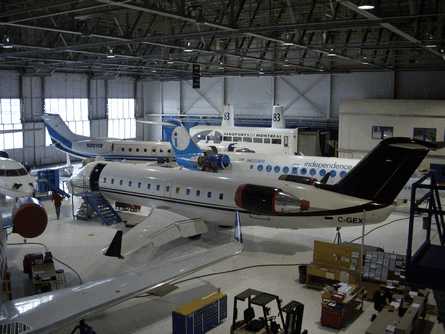Canada's MJET plans to certificate early next year the first Bombardier CRJ200 capable of flying VIPs over 5,550km (3,000nm) and is preparing to double capacity of its Montreal completion centre to meet growing demand for CRJ business jet conversions.
The Canadian engineering company early this year began work converting a CRJ200 from standard passenger airline to long-range executive configuration for Calgary-based Corpac Canada. Taif Rahman, co-chairman of MJET parent Elisen Technologies, says the aircraft is scheduled to be completed late this year and supplemental type certificate for the new Elisen-designed auxiliary fuel tank system early next year should be secured in early 2009.
 |
|---|
© MJET |
Rahman says the new STC features three auxiliary fuel tanks in a new more efficient configuration that allows the aircraft to pass "the magic 3,000nm" barrier and operate several important business sectors without a fuel stop, including Dubai-London. MJET's auxiliary fuel tank system will offer an additional 2,040kg (4,500lb) or 2,555 litres (675USgal) of fuel, enabling CRJ200s to fly 5,735km with five passengers.
The two existing STCs for CRJ200 with auxiliary fuel tanks, held by Canada's Flying Colours and Delaware-based PATS Aircraft, expand the range from about 3,880km to just under 5,550km. Bombardier Asset Management Group director of sales Warren Hoppe says the PATS STC can carry an additional 1,800kg or 2,250 litres of fuel and the Flying Colours STC an additional 1,815kg or 2,275 litres.
Rahman says MJET was able to expand the capacity of the auxiliary fuel tank system by not placing all the tanks in the traditional spot at the aft lavatory and introducing a lighter, more efficient and more modern design.
To accommodate the larger tanks, Rahman says MJET has taken weight out of the aircraft by removing structures that were only needed for passenger airline configuration and by using lighter composite materials for some interior fittings. "We had to take out weight. There's no point only being able to carry two passengers at full range," Rahman says.
 |
|---|
© MJET |
MJET also claims it will have the only STC for CRJ100/200 auxiliary fuel tank conversions that meets new FAA flammability requirements.
In anticipation of securing the new STC, MJET plans to begin conversion work on a second and third aircraft by year-end for undisclosed customers. It is confident additional commitments will soon be secured as the price of CRJ200s continues to fall due to record low demand for 50-seaters in the regional airline sector. While the current economic downturn could lead to reduced demand for corporate jets, in particular in North America, Rahman says most of the interest in CRJ conversions comes from overseas and the backlog for new business jets of the CRJ200's size remain two to three years.
"We don't have a crystal ball, but a lot of our customers are coming from a different marketplace," Rahman says. "A lot of our interest is from Russia, Middle East and India."
To meet the demand, Rahman expects MJET will complete between six and 10 CRJ100/200 conversions next year. Its current facility at Montreal's Trudeau airport can handle five aircraft simultaneously, but Rahman says MJET is now looking to move to a new site at the airport in 2010 that will double its capacity.
While its expansion is based largely on the CRJ200 market, Rahman says MJET is also looking at several new products. MJET provides a mix of maintenance, refurbishment and modification services for several aircraft types.
While this is the first time MJET has outfitted auxiliary fuel tanks on a CRJ, it is not new to the CRJ conversion market, having converted a handful of aircraft over the past several years, from airline to standard range corporate shuttle configuration. Elisen, a Montreal-based engineering firm that took over MJET last year, has performed product development work for several manufacturers including Bombardier and was responsible for designing the new MJET auxiliary fuel tank system for the CRJ100/200. Elisen was previously only a minority shareholder in MJET.
Source: Flight International
















